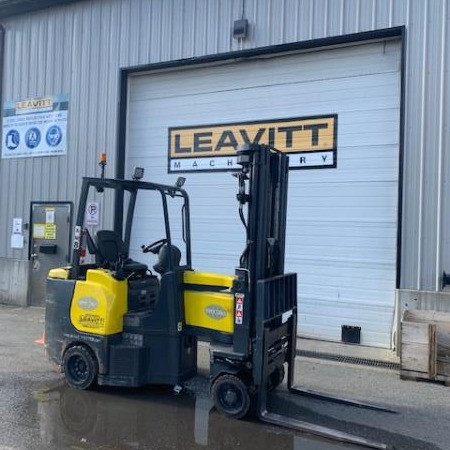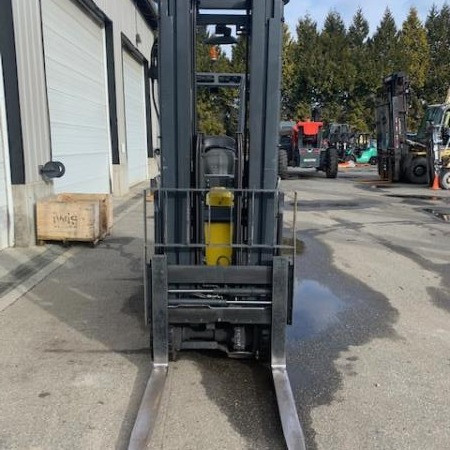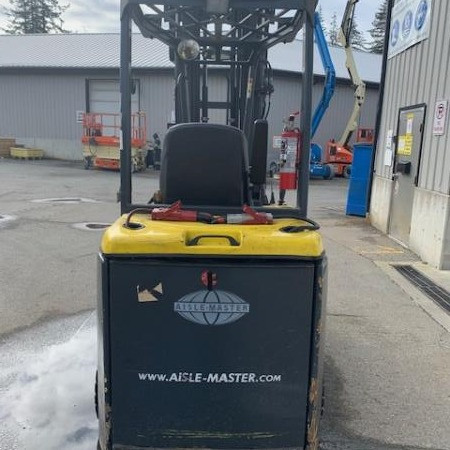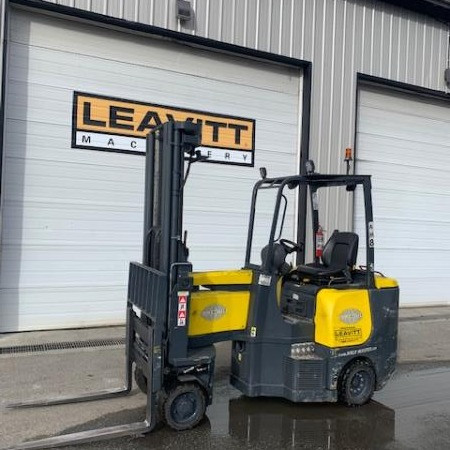Very Narrow Aisle Forklift Orange
Used Very Narrow Aisle Forklift Orange - Warehousing needs greatly focus on space-saving techniques and layout to maximize expensive square footage and decrease travel time needed to get goods from the loading docks and from point A to point B. Extremely narrow aisles offer more storage space since there is less space needed for aisle access. These warehouse configurations are often referred to as warehouse optimization.
Warehouse Optimization
Several benefits can be enjoyed for adding very narrow aisle warehouse optimization such as more storage space for the facility.
Because very narrow forklift trucks were developed to take up less space in maneuvering, it is now possible to decrease warehouse aisle width to less than half the width required by standard forklifts. Numerous narrow aisle forklifts deliver better stacking heights to increase the storage capacity on a square foot basis. Costs can be drastically decreased with a narrow aisle forklift compared to a standard aisle configuration as less warehouse space is required for the same quantity of stock. Most urban locations have expensive square footage; therefore, reducing costs is a benefit to warehouses and their business. Adding a very narrow aisle width system can increase storage up to eighty percent when planned properly. In addition, a very narrow aisle layout allows for more rack faces as well as better access to products. Since greater quantities of products are situated in a more accessible area, there is less travel time needed for gathering and storing items.
It is common for warehouses to use a very narrow or narrow aisle layout. Narrow aisles are measured as those that use fewer than eleven feet of aisle width. These widths reduce even further to roughly 6.5 feet for very narrow aisles. Both of these aisle widths provide significantly increased storage opportunities. However, they also create challenges when turning within the aisles using forklifts for stocking and order picking. These challenges are met by using very narrow forklifts to gain access and complete tasks.
It is necessary to know the dimensions of the aisle when selecting a forklift for a certain job. Having the right aisle dimensions will save money and time instead of purchasing the wrong forklift that won’t be able to conquer the applications. It is essential to take any columns, posts or utilities into account before deciding a type of narrow aisle forklift design as these can block access.
Very Narrow Aisle Forklift Trucks
Very narrow aisle forklift trucks are almost always powered electrically, usually by rechargeable battery. These very narrow aisle trucks are more commonly available as stand-up riders, which helps increase productivity and operator comfort. The most popular kinds of very narrow aisle forklift trucks include turret or swing-mast, end-control riders, order pickers and reach trucks.
Reach Forklift Trucks
Reach trucks were designed as a version of the rider stacker forklift but specially modified for use in narrow aisles. It got its name by its function of reaching its forks forward to get to a load. The moving mast and the moving carriage are two types of reach trucks. The moving carriage functions by lowering and raising the carriage and the operator. The moving mast raises and lowers the forks as the operator remains at ground level. Of the two kinds of reach trucks, the moving mast reach truck is the safer of the two varieties. These machines rely on a kind of jointed framework known as a pantograph system that enables the operator to place a load or reach the load without moving the machine.
Order Pickers
Order pickers have been designed and developed specifically for use in picking orders from high, typically hard-to-reach racks. They are used for smaller picking items that can be lifted and moved by hand. They lift the operator up to reach the goods by identifying and choosing certain items to create an order.
End-Control Riders
End-control riders can pick up loads along the floor level and transport goods horizontally instead of transporting items over heights.
Turret or Swing-Mast Forklift
Swing-mast or turret very narrow aisle forklifts feature an articulating swivel mast that pivots. The mast swivels allowing pallets to be placed on either the left or right of the forklift.
Guided Very Narrow Aisle Trucks
Many very narrow aisle forklift trucks are able to be guided down aisles by wire or rail.
Thanks to the guide rails, the possibility of crashing into racks is greatly reduced. In rail-guided models, sets of rails are placed into the floor on each side of the aisle. They run the length of the aisle and also curve around the aisles’ edge. Specific wheel guides are on the forklift. These slide into the rails to stop the forklift from moving out of the rail guards.
Running down the center of the aisle, wire-guidance forklifts rely on floor wires instead of rails. The wire-guides function similarly to the rail systems except the forklift has a wire-guide system to prevent the machine from traveling where it is not supposed to.
Work Site Considerations
Certain essential considerations need to be dealt with before using a narrow aisle configuration. Because these very narrow aisle configurations include very tall racking systems, the condition of the floor and the construction of the racks must be done properly in order to avoid potentially disastrous outcomes. Four specific areas need to be perfectly prepared before a racking system can be implemented including a level floor, plumb racks, any floor cracks need to be repaired and the floor’s load capacity must be accurate. These locations need to be maintained and monitored continuously.
Level Floor
Because of the height of the racking systems, any slight slope of the floor is likely to negatively affect the plumbness of the racks, especially over time when loads are continuously placed and removed on the racks. Without this foundation of a level floor, the stability of the racks could be jeopardized.
Crack Repair
When there are floor cracks found, they need to be assessed and immediately fixed for safety concerns. Cracks may affect the floor’s level and, when they are approximately 3/8 inches wide, will need to be properly filled with a material at least as hard as the surrounding floor.
Floor Load Capacity
The floor needs to meet specific minimum requirements prior to a narrow aisle configuration. Minimum flooring requirements include concrete measuring three thousand psi and rebar distributed evenly three to four inches below the surface. Depending on the load requirements and configuration, additional reinforcements may be needed.
Plumb Racks
Installing the racks safely and correctly is vital for the entire system. There is a major chance of rack failure if improper installation occurs. All racks need to be plumb and this is one of the most vital aspects of correct installation. If necessary, rack shims should be used to ensure the racks are plumb within 1 inch at the 30 foot height of the racks.
Racking failure can happen if the aforementioned measures are not taken or implemented correctly. Employees can become hurt or killed in the event that racking failure occurs. Goods can be damaged along with forklifts and other equipment. Due to these potential problems, the most significant part of creating a narrow aisle configuration for warehousing optimization is the initial measurements.
Very Narrow Aisle Forklift PDF
Stock Number: 208758 GL
Make: AISLEMASTER
Model: 44SE
Year: 2015
| Stock Number |
208758 GL |
| Make |
AISLEMASTER |
| Model |
44SE |
| Year |
2015 |
| Category |
Very Narrow Aisle Forklift |
Stock Number: 209213 GL
Make: AISLEMASTER
Model: 44SE
Year: 2015
| Stock Number |
209213 GL |
| Make |
AISLEMASTER |
| Model |
44SE |
| Year |
2015 |
| Category |
Very Narrow Aisle Forklift |
Stock Number: 207213 GL
Make: AISLEMASTER
Model: 44E
Year: 2013
| Stock Number |
207213 GL |
| Make |
AISLEMASTER |
| Model |
44E |
| Year |
2013 |
| Category |
Very Narrow Aisle Forklift |













